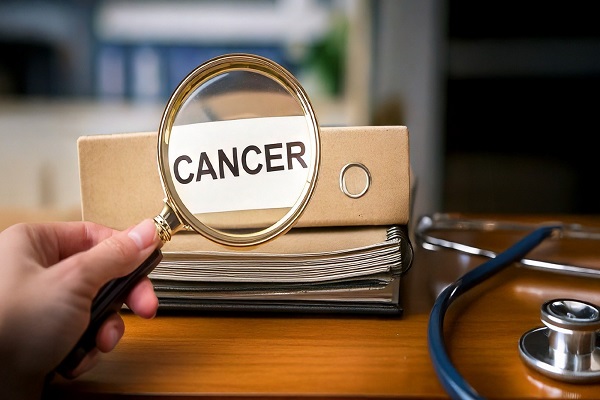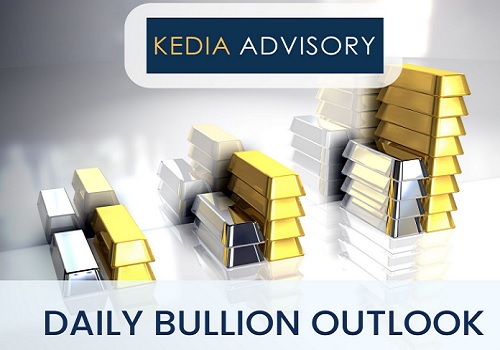Gold trading range for the day is 96175-97835 - Kedia Advisory

Gold
Gold prices declined by 0.41% to settle at 97,090, pressured by easing geopolitical tensions after reports emerged that U.S. and Chinese officials are scheduled to meet this week. This move towards dialogue has reduced safe-haven demand, which typically supports gold during periods of global uncertainty. However, broader fundamentals remain supportive of gold in the medium term. China continues to show strong official and retail demand. The People's Bank of China added to its gold reserves for the sixth consecutive month in April, with holdings rising to $243.59 billion from $229.6 billion in March. Meanwhile, bar and coin demand in China surged by 30% year-on-year in Q1 2025, and total bar and coin investment rose 14% globally despite a 32% drop in coin demand alone. The World Gold Council reported a 1% increase in global gold demand in Q1 2025 to 1,206 metric tons, driven by a 170% jump in investment inflows into ETFs. In India, gold swung from a discount to a premium for the first time in five months amid a price correction and festive buying. Dealers shifted from offering up to $80 discounts to charging a $3 premium by week's end, reflecting improved local sentiment. Chinese premiums also remained robust at $34–$48/oz, indicating tight local supply. Technically, the gold market is under long liquidation as open interest fell slightly by 0.14% to 15,218. Immediate support is at 96,630, with further downside possible toward 96,175. Resistance is seen at 97,460, and a breakout above this could push prices to 97,835.
Trading Ideas:
* Gold trading range for the day is 96175-97835.
* Gold slipped following reports that US and Chinese officials are set to meet this week.
* The Federal Reserve kept the funds rate at 4.25%–4.50% range for a third consecutive meeting
* China's central bank buys gold for sixth straight month in April
Silver
Silver prices fell by 1% to settle at 95,733 amid easing geopolitical concerns following news of upcoming U.S.-China trade talks. The anticipated meeting in Switzerland between U.S. and Chinese officials has dampened safe-haven demand, weighing on precious metals. In addition, better-than-expected U.S. economic data further reduced investor appetite for non-yielding assets like silver. The U.S. ISM Services PMI rose to 51.6 in April from 50.8 in March, surpassing expectations, while the trade deficit widened to a record $140.5 billion, reflecting a complex macroeconomic environment. Despite the short-term price weakness, silver’s longer-term fundamentals remain robust. The global silver market is forecast to post a significant deficit for the fifth straight year in 2025. Industrial demand is projected to rise by 3%, crossing 700 million ounces for the first time, largely driven by green economy applications such as solar panels and EV technologies. Physical investment demand is expected to rebound 3%, particularly in Western markets, while demand for coins and bars is forecast to rise 7% after a sharp 22% decline in 2024. The Silver Institute expects the global supply-demand deficit to narrow by 21% to 117.6 million ounces, owing to a modest supply increase and a small dip in overall demand. Technically, the market is showing fresh selling pressure as open interest rose 3.38% to 17,237 contracts. Immediate support is at 95,225, with further downside potential toward 94,710, while resistance lies at 96,565, and a breakout above could see prices testing 97,390.
Trading Ideas:
* Silver trading range for the day is 94710-97390.
* Silver dropped as optimism over potential U.S.-China trade talks weakened demand for safe-haven assets.
* U.S. President Trump said he and top administration officials will review potential trade deals over the next two weeks to decide which ones to accept.
* U.S. Treasury Secretary Scott Bessent and chief trade negotiator Jamieson Greer will meet top Chinese economic official He Lifeng for talks.
Crude oil
Crude oil prices declined by 1.16% to settle at 4,953 amid persistent concerns over global demand and oversupply risks. The downward pressure followed news that OPEC+ plans to accelerate production increases, fueling fears of a market glut at a time when U.S. tariffs are already weighing on economic activity and energy consumption. The Energy Information Administration (EIA) reported a U.S. crude inventory drawdown of 2.032 million barrels for the week ending May 2, slightly above expectations but not enough to offset bearish sentiment. Meanwhile, gasoline inventories rose by 188,000 barrels, while distillates fell by 1.107 million barrels, suggesting a mixed demand picture across refined products. On the supply front, total U.S. production edged up to 13.16 million barrels per day in February, buoyed by increased output from Texas and New Mexico. Despite this uptick, some U.S. shale producers, including Diamondback Energy and Coterra Energy, are scaling back drilling activity, signaling a potential correction in response to weak prices. Rail shipments of crude also dropped, further highlighting evolving logistical dynamics. Globally, the International Energy Agency (IEA) revised down its 2025 oil demand growth forecast by 70,000 bpd to 1 million bpd, citing a sluggish macroeconomic climate and underwhelming Q4 2024 and Q1 2025 demand. Technically, crude oil is under long liquidation, with open interest falling 2.92% to 16,934. Immediate support lies at 4,890, and a break below could test 4,826. Resistance is seen at 5,064, with a move above opening the path to 5,174.
Trading Ideas:
* Crudeoil trading range for the day is 4826-5174.
* Crude oil dropped amid lingering concerns about the outlook for global demand.
* Crude oil inventories in the US fell by 2.032 million barrels, more than market expectations of a 1.7 million barrel decrease.
* OPEC+ announced plans to accelerate production increases, raising oversupply fears.
Natural gas
Natural gas prices surged by 4.38% to settle at 304.9, supported by a combination of falling production and strong export momentum, particularly in liquefied natural gas (LNG). Output in the U.S. dropped by around 4.8 billion cubic feet per day (bcfd) to a seven-week low of 102.6 bcfd, providing a bullish signal to the market. Meanwhile, LNG exports hit a record average of 16.0 bcfd in April, reaffirming the U.S.'s position as the world’s top LNG exporter amid persistent global demand. Weather forecasts further added support, with meteorologists predicting warmer-than-normal temperatures across the Lower 48 states through May 21, which could increase cooling demand and thus natural gas consumption. However, the U.S. Energy Information Administration (EIA) reported a surprisingly large storage build of 107 billion cubic feet (bcf) for the week ending April 25, exceeding last year’s 64 bcf and the five-year average of 58 bcf. This increase was largely attributed to mild weather conditions during the reporting week. Even with the strong build, storage levels remain 17.6% higher than the same period last year and slightly above the five-year average, indicating adequate supply. Looking ahead, the EIA projects record-breaking gas output and consumption in 2025, forecasting dry gas production to reach 104.6 bcfd, rising further to 107.3 bcfd in 2026. Technically, the market is under fresh buying, evidenced by a sharp 20.85% increase in open interest to 12,750. Support is seen at 299.2, with a breach potentially leading to 293.5, while resistance is at 310.1, and a breakout could test 315.3.
Trading Ideas:
* Naturalgas trading range for the day is 293.5-315.3.
* Natural gas rose driven by a drop in output and record LNG exports.
* Production was on track to drop by around 4.8 bcfd to a seven-week low of 102.6 bcfd.
* LNG exports hit a record average of 16.0 bcfd in April.
Copper
Copper prices slipped by 0.61% to settle at 846 amid broad-based weakness driven by lackluster global manufacturing data and shifting inventory dynamics. Disappointing PMI figures from major economies have raised concerns over slowing industrial activity, directly impacting copper demand. Additionally, a surge in inventories in North American warehouses—prompted by stockpiling ahead of potential new U.S. tariffs—has further pressured prices. From a supply standpoint, Chile, the world’s top copper producer, reported a 9.1% year-on-year rise in March output to 477,049 metric tons, reinforcing global supply strength. In contrast, inventories on the Shanghai Futures Exchange declined by 23.5%, indicating ongoing demand within China’s domestic market despite weaker import data. Chinese imports of unwrought copper and copper products fell 1.4% in March and are down 5.2% for the year to date, as higher U.S. copper prices diverted refined copper shipments away from China. According to the International Copper Study Group (ICSG), the global refined copper market recorded a 61,000 metric ton surplus in February, a slight narrowing from January’s 90,000-ton surplus. When factoring in bonded warehouse inventories in China, February’s adjusted surplus stood at 76,000 tons, indicating a mildly improving supply-demand balance. Technically, the copper market is under long liquidation, with a marginal 0.06% drop in open interest to 6,946. The price now finds support at 842.4, with further downside likely toward 838.8 if breached. On the upside, resistance is expected at 851.2, and a breakout above this could push prices toward 856.4.
Trading Ideas:
* Copper trading range for the day is 838.8-856.4.
* Copper dropped amid disappointing manufacturing PMI reports in major economies, signaling weaker demand.
* Copper inventories surged in North American warehouses as US manufacturers ramped up stockpiling.
* China’s central bank announced plans to lower key policy rates amid efforts to support growth in the face of US tariffs.
Zinc
Zinc prices edged down by 0.10% to settle at 246.6 amid sustained macroeconomic pressures and growing supply expectations. The ongoing U.S.-China trade tensions have continued to weigh on market sentiment, with retaliatory tariffs now reaching as high as 145% on key goods. These escalating measures are clouding the outlook for global manufacturing, which is critical for zinc demand, especially in sectors like construction and automotive. On the supply front, optimism around a mining rebound in 2025 is adding to the bearish sentiment. Increased capacity additions in Russia and the Democratic Republic of Congo are expected to elevate mined zinc output by 4.3% to 12.43 million tons, after three years of declines due to mine closures. China’s refined zinc production rose by nearly 14% month-on-month and over 4% year-on-year in March 2025. Despite a cumulative 3% YoY decline for January to March, the March output exceeded expectations due to resumed operations after the Chinese New Year and increased production in key provinces like Shaanxi, Inner Mongolia, and Sichuan. Higher sulphuric acid prices and improved zinc concentrate treatment charges boosted smelter activity. Additionally, zinc alloy output also saw a month-on-month increase. Technically, the zinc market is under long liquidation, as evidenced by a 7.79% drop in open interest to 2,709. The price has immediate support at 245.6, with further downside potential toward 244.4. On the upside, resistance is seen at 248.1, and a breakout could push prices to 249.4.
Trading Ideas:
* Zinc trading range for the day is 244.4-249.4.
* Zinc dropped amid lingering concerns about the broader economic impact from trade disputes.
* The global refined zinc market will be in surplus this year, the International Lead and Zinc Study Group (ILZSG) said.
* In March 2025, China's refined zinc production increased by nearly 14% MoM and over 4% YoY
Aluminium
Aluminium prices declined by 1.36% to settle at 228.75, pressured by persistent macroeconomic headwinds and oversupply concerns, despite ongoing economic support measures from China. The U.S. economy shrank in Q1 2025 for the first time in three years, largely due to a surge in imports aimed at avoiding new tariffs under the Trump administration. The IMF now expects U.S. GDP to grow at a modest 1.8% in 2025, further weakening global demand sentiment for industrial metals like aluminium. On the supply side, the market remains well-supplied. Global primary aluminium output in March rose 2.3% year-on-year to 6.227 million tonnes, according to the International Aluminium Institute (IAI). China's aluminium production alone grew by 2.6% YoY in Q1 2025, nearing the government’s long-standing annualised production cap of 45 million tonnes. Meanwhile, China's March production hit 3.75 million tonnes—up 4.4% YoY—bringing the Q1 total to 11.07 million tonnes, a 3.2% annual increase. Exports from China also surged, with 5.5 million tonnes of unwrought aluminium and related products shipped in the first ten months of the fiscal year, up 17% YoY. Goldman Sachs cut its aluminium price outlook, citing slower global growth and surging supply, projecting a Q3 2025 low of $2,000 per metric ton. Technically, aluminium is under fresh selling pressure, evidenced by a 0.6% rise in open interest to 5,212. The price is now testing support at 227.8, with a break potentially leading to 226.6. Resistance is seen at 230.9, and a move above could push prices toward 232.8.
Trading Ideas:
* Aluminium trading range for the day is 226.6-232.8.
* Aluminium fell amid the backdrop of ample supply and lingering macroeconomic headwinds.
* Output is increasing, with alumina producers in Guinea, Australia, and China expanding capacity.
* Global primary aluminium output in March rose 2.3% year on year to 6.227 million tonnes
Cottoncandy
Cottoncandy prices inched up marginally by 0.02% to settle at 54,510 amid a mix of supportive fundamentals and subdued mill demand. The Cotton Association of India (CAI) further trimmed its domestic crop estimate by 4 lakh bales to 291.30 lakh bales for the 2024–25 season, primarily due to lower production in Maharashtra. This downward revision, based on end-March inputs from state associations, adds to concerns about tightening domestic supply. Total cotton supply till March-end is estimated at 306.83 lakh bales, inclusive of 25 lakh bales of imports and 30.19 lakh bales of opening stock. Of this, 127.83 lakh bales remain as end-March stocks, with a significant portion (100.83 lakh bales) held by CCI, Maharashtra Federation, and trade participants. Cotton exports for 2024–25 are projected at just 16 lakh bales, significantly down from the previous year’s 28.36 lakh bales. Meanwhile, cotton imports are expected to more than double to 33 lakh bales, underscoring growing dependence on overseas supply amid domestic production shortfall. Globally, the U.S. reduced its export forecast by 100,000 bales to 10.9 million bales, with a corresponding rise in ending stocks. World cotton production and consumption have also been revised downward, though stockpiles are set to increase. Technically, the market is under short covering, as reflected by a 1.22% drop in open interest to 243. Cottoncandy is finding support at 54,300, with further downside likely at 54,100. Resistance is seen at 54,850, and a break above could push prices toward 55,200.
Trading Ideas:
* Cottoncandy trading range for the day is 54100-55200.
* Cotton settled flat as CAI expects a shrinkage in the domestic crop
* CAI has estimated the total cotton supply till the end of March including the imports at 306.83 lakh bales.
* Cotton exports for the 2024-25 season are pegged at 16 lakh bales, lower by 12.36 lakh bales
* In Rajkot, a major spot market, the price ended at 26121.4 Rupees dropped by -0.06 percent.
Turmeric
Turmeric prices rose by 0.49% to settle at 14,000, supported by persistent concerns over low arrivals and expectations of reduced production despite a 10% increase in the sown area to 3.30 lakh hectares this season. While acreage has expanded, productivity gains remain elusive due to adverse weather conditions, including untimely rains that have impacted crop health, especially in key producing areas like Nanded, where smaller rhizomes and crop rot are being reported. Overall, yields are expected to be 10–15% lower than last year’s 10.75 lakh tonnes. Despite these supply-side concerns, upside momentum remains capped due to a notable surge in daily arrivals, which rose to 57,500 quintals, up sharply from 29,860 quintals in the prior session, and relatively tepid export demand. Turmeric exports from April to January 2025 saw a healthy year-on-year increase of 12.93%, reaching 1.49 lakh tonnes, but recent monthly data reflects a short-term decline. Exports in January 2025 fell 23.17% from December but were still 12.18% higher than January 2024. Conversely, imports surged by 70.13% during the same period, suggesting increased domestic demand or price competitiveness, though January 2025 saw a sharp month-on-month and year-on-year drop in imports, possibly due to ample local arrivals. Technically, the market is under fresh buying, with open interest jumping by 12.79% to 12,255. Immediate support is at 13,846, with a downside test possible at 13,690. On the upside, resistance is seen at 14,114, and a break above could take prices to 14,226.
Trading Ideas:
# Turmeric trading range for the day is 13690-14226.
# Turmeric gains amid as persistent concerns about arrivals and lower production estimates.
# Support also seen amid concerns over slow growth of rhizomes and low yield estimates persist.
# New crop yields are expected to be 10-15% lower this year, with the Nanded region particularly affected
# In Nizamabad, a major spot market, the price ended at 14342.85 Rupees gained by 0.31 percent.
Jeera
Jeera prices declined by 0.18% to settle at 21,715, pressured by subdued domestic and export demand, alongside rising supply. Traders noted a seasonal slowdown in retail buying, compounded by weak participation from international buyers. Comfortable stocks and adequate availability have further weighed on sentiment, with total arrivals in major mandis increasing to 32,900 bags, up from 28,000 in the previous session, adding to supply-side pressure. Production in the current season is anticipated to match last year’s levels due to favorable crop conditions, despite a delay in sowing by nearly a month in key producing states like Gujarat and Rajasthan due to adverse weather. While about 20 lakh bags remain with farmers, only 3–4 lakh bags are expected to be actively traded, leaving a sizable carry-forward stock of approximately 16 lakh bags, which continues to cap prices. On the trade front, Jeera exports surged by 66.98% year-on-year during April to January 2025 to reach 1.82 lakh tonnes. However, January exports fell 5.50% month-on-month, indicating a short-term drop in overseas demand. Meanwhile, imports plummeted by 93.84% to just over 1,070 tonnes during the same period, reflecting domestic oversupply or sufficient local availability. Technically, the market is under fresh selling pressure, evidenced by a 12.11% increase in open interest to 4,221. Jeera now finds support at 21,120, with a break below possibly testing 20,520. On the upside, resistance is at 22,080, with potential to test 22,440.
Trading Ideas:
* Jeera trading range for the day is 20520-22440.
* Jeera prices declined due to lower buying from domestic buyers and subdued export demand.
* Total arrivals in major mandis rose to 32,900 bags from 28,000 bags in the previous session, increasing supply side pressure.
* Traders attributed the fall mainly to the conclusion of the retail season and continued inactivity on the part of foreign buyers.
* In Unjha, a major spot market, the price ended at 22075.95 Rupees dropped by -0.44 percent.
Views express by all participants are for information & academic purpose only. Kindly read disclaimer before referring below views










More News

Daily Key Price Levels Report - 10 July 2025 by Kotak Securities Ltd













